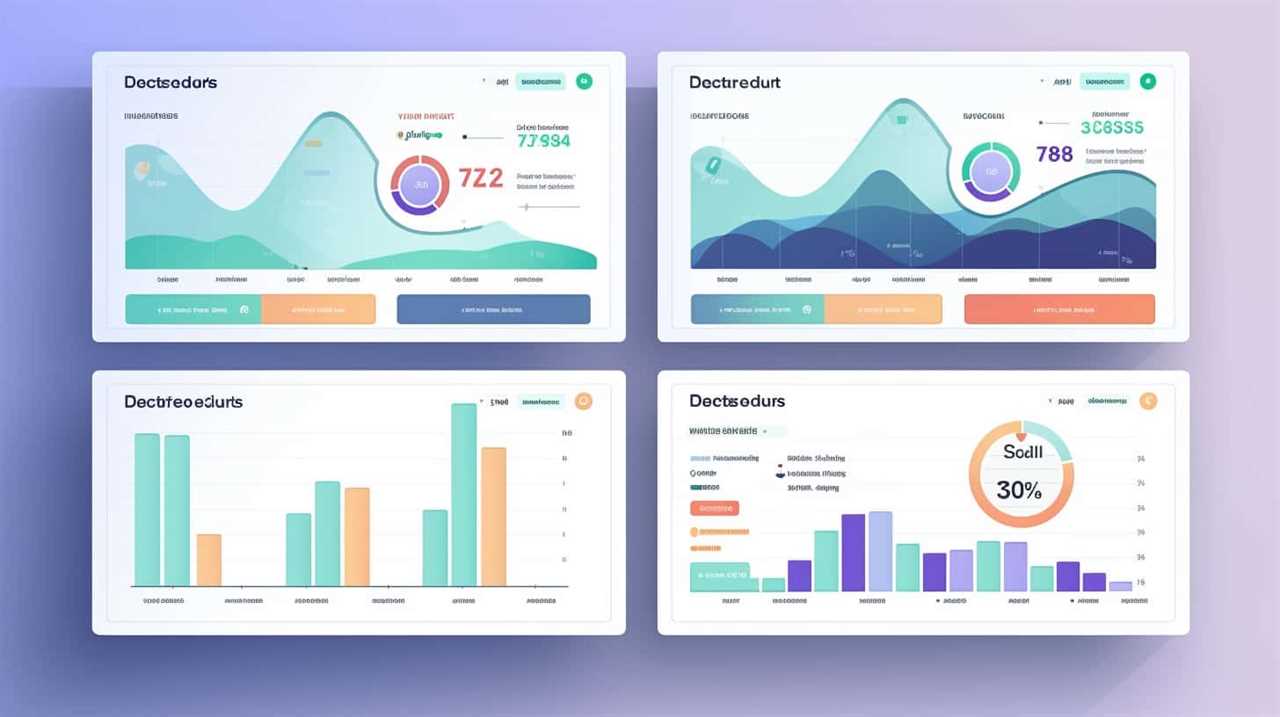Tired of the relentless quest to evaluate a source’s credibility? We’ve got your back!
In this article, we present 14 effective methods to evaluate topical authority quality. From keyword analysis to social media presence examination, we’ll empower you with the tools to separate the reliable from the unreliable.
Say goodbye to uncertainty and join us on a journey towards liberation from misinformation.
Let’s dive in and uncover the truth together!

Key Takeaways
- Keyword analysis and content relevance assessment are crucial in driving relevant traffic to a website and ensuring the effectiveness of the content.
- Backlink profile evaluation helps assess the authority and credibility of a website or webpage.
- Social media presence examination and platform-specific strategy evaluation contribute to understanding user behavior and the effectiveness of a brand’s online presence.
- Evaluating trustworthy expert sources and evaluating credentials and experience are important in determining the credibility and expertise of the information provided.
Keyword Analysis
In our evaluation of topical authority quality, we rely on keyword analysis to identify and analyze the effectiveness of keywords in driving relevant traffic to a website.
Keyword research plays a crucial role in search engine optimization (SEO) as it helps us understand the language and phrases that users are using to search for information.
By conducting thorough keyword research, we can discover the most relevant and high-performing keywords to target in our content. This allows us to optimize our website and improve its visibility in search engine results pages.
Moreover, keyword analysis helps us assess the competitiveness of certain keywords and identify opportunities for ranking higher.

Content Relevance Assessment
To assess the relevance of content, we start by examining its alignment with the needs and interests of our target audience. This is crucial in determining the effectiveness and value of the content.
Here are three important factors to consider in content relevance assessment:
- Audience Research: Conduct thorough research to understand the demographics, preferences, and pain points of your target audience. This will help you create content that resonates with them and addresses their specific needs.
- Keyword Analysis: Analyze relevant keywords and phrases that your audience is searching for. Incorporate these keywords strategically in your content to ensure it aligns with their interests and improves its visibility in search engines.
- Content Alignment: Evaluate how well your content aligns with the overall purpose and goals of your website or brand. Ensure that it provides valuable insights, answers questions, and offers solutions that your audience is seeking.
Backlink Profile Evaluation
Our article delves into the evaluation of the backlink profile to determine the quality of topical authority. Backlink analysis plays a crucial role in assessing the authority of a website or webpage. By examining the quantity, quality, and relevance of backlinks, we can gain insights into the website’s credibility and expertise on a particular topic. One important aspect of backlink analysis is anchor text evaluation. This involves examining the text used in the hyperlinks that point to a webpage. The anchor text provides context and relevance to the linked page, giving search engines an understanding of what the page is about. By evaluating the anchor text, we can determine if the backlinks are coming from reputable sources and if they are using relevant keywords.
To illustrate the importance of anchor text evaluation in backlink analysis, consider the following table:

| Anchor Text | Description |
|---|---|
| Natural Language Anchor Text | Includes phrases that provide context to the linked page, using natural language and relevant keywords. Example: "best tips for weight loss" |
| Exact Match Anchor Text | Uses the exact keyword or phrase that the linked page is targeting. Example: "weight loss tips" |
| Branded Anchor Text | Includes the name of the brand or website being linked to. Example: "Visit WeightLossExperts.com" |
Social Media Presence Examination
When evaluating topical authority quality, it’s important to consider engagement metrics on social media platforms. These metrics indicate the level of interaction and interest in a brand or individual’s content, providing insight into their influence and credibility.
Additionally, it’s crucial to evaluate the platform-specific strategies employed by the entity being examined, as each social media platform has its own unique features and audience demographics that can impact the effectiveness of their presence.
Engagement Metrics Importance
We frequently analyze engagement metrics to assess the importance of social media presence in evaluating topical authority quality. These metrics provide valuable insights into user behavior and the effectiveness of a brand’s online presence.
Here are three key reasons why engagement metrics are important in assessing topical authority quality:

- User behavior: Engagement metrics allow us to understand how users interact with a brand’s content on social media platforms. By analyzing metrics such as likes, shares, and comments, we can gain insights into the level of interest and engagement generated by the brand’s content.
- Conversion rate: Engagement metrics also help us measure the effectiveness of a brand’s social media presence in driving conversions. By tracking metrics such as click-through rates and conversion rates, we can determine how well the brand’s content is converting followers into customers.
- Brand visibility: Engagement metrics provide an indication of a brand’s visibility and reach on social media. Metrics such as reach and impressions help us understand how many people are exposed to the brand’s content, allowing us to assess its overall impact and influence.
Platform-Specific Strategy Evaluation
Continuing with the analysis of engagement metrics, we can now delve into evaluating the effectiveness of platform-specific strategies in examining social media presence. Platform-specific targeting and audience segmentation are crucial aspects of any social media strategy. By tailoring content to specific platforms, businesses can reach their target audience more effectively and increase engagement rates.
To evaluate the effectiveness of platform-specific strategies, it is essential to assess various metrics such as reach, engagement, and conversion rates. These metrics can provide insights into the success of specific strategies on different platforms. By comparing the performance of different strategies across platforms, businesses can identify which platforms are most effective for reaching their target audience and adjust their strategies accordingly.
To illustrate this evaluation process, we can use the following table:
| Platform | Reach | Engagement | Conversion |
|---|---|---|---|
| High | Moderate | Low | |
| Moderate | High | Moderate | |
| Low | Low | Low | |
| Moderate | Moderate | High |
Expertise Evaluation
When evaluating expertise, it’s crucial to consider trustworthy expert sources, such as renowned professionals or reputable institutions.

We should also assess the credentials and experience of the individuals or organizations providing the information.
Additionally, consistency in delivering accurate and up-to-date knowledge is key.
Trustworthy Expert Sources
To assess the quality of topical authority, it’s essential to evaluate the credibility and expertise of trustworthy expert sources. When evaluating the trustworthiness of expert sources, consider the following:
- Reputation: Look for sources that have a solid reputation in their field. This can be determined by their experience, credentials, and the recognition they’ve received from their peers.
- Consistency: Trustworthy expert sources should consistently provide accurate and reliable information. Look for sources that have a track record of producing high-quality content and have a reputation for being consistent in their expertise.
- Transparency: Expert sources that are trustworthy are transparent about their methods, sources, and potential conflicts of interest. They should be open about their biases and provide clear and verifiable evidence to support their claims.
Evaluating Credentials and Experience
One effective method for evaluating the quality of topical authority is to assess the credentials and experience of expert sources. When evaluating qualifications, it’s important to consider the educational background, professional experience, and relevant certifications of the experts. By assessing expertise, we can determine if the sources have the necessary knowledge and skills in the specific field or topic.

This evaluation provides assurance that the information provided is accurate and reliable. It’s crucial to look for experts who have a track record of success and a strong reputation within their industry. Additionally, checking for any publications or research they have conducted can further support their credibility.
By evaluating credentials and experience, we can ensure that the sources we rely on are truly authoritative.
Transitioning into the next section, let’s now explore the importance of consistency in delivering knowledge.
Consistency in Delivering Knowledge
We consistently strive to deliver knowledge with accuracy and reliability. When evaluating topical authority, it’s important to consider the consistency in which knowledge is provided.

Here are three key factors to consider when evaluating the consistency of knowledge delivery:
- Consistent and up-to-date information: It’s crucial for authoritative sources to consistently provide accurate and up-to-date information. This ensures that the knowledge being shared is relevant and reliable.
- Clarity in communication: Clear and concise communication is essential for delivering knowledge effectively. Authoritative sources should present information in a way that’s easy to understand and avoids confusion.
- Reliable sources and citations: To maintain credibility, authoritative sources should rely on reputable sources and provide proper citations for the information they present. This helps readers verify the accuracy and reliability of the knowledge being shared.
User Engagement Analysis
User engagement analysis plays a crucial role in evaluating the quality of topical authority. By analyzing content engagement and user behavior, we can gain valuable insights into how users interact with the content and determine the level of topical authority it possesses.
Content engagement refers to the extent to which users interact with the content, such as likes, comments, and shares. User behavior analysis, on the other hand, focuses on how users navigate through the content, their time spent on each page, and their click-through rates.
Author Credibility Assessment
As experts in evaluating topical authority quality, we frequently assess author credibility to ensure the reliability and expertise of the content. Author expertise assessment is crucial in determining the credibility of the information provided. Here are three key factors we consider when evaluating author credibility:

- Qualifications and credentials: We examine the author’s background, education, and experience in the subject matter. This helps us determine their level of expertise and whether they possess the necessary qualifications to write authoritatively on the topic.
- Reputation and recognition: We look for signs of recognition within the industry or academic community. This includes awards, citations, and endorsements from reputable sources. A respected and well-known author is more likely to have established credibility.
- Consistency and accuracy: We analyze the author’s past work to assess their consistency in providing accurate and reliable information. If an author consistently produces well-researched and fact-checked content, it adds to their credibility.
Domain Authority Review
One important aspect to consider when evaluating topical authority quality is conducting a review of domain authority. Domain authority ranking plays a crucial role in determining the credibility and relevance of a website within a specific topic or industry. By evaluating the domain authority, we can assess the overall strength and trustworthiness of a website.
A high domain authority indicates that the website has established itself as a reputable source of information, while a low domain authority suggests that the website may not have the necessary expertise or authority in the given subject. When evaluating topical relevance, it’s essential to consider the domain authority of the website to ensure that the information provided is reliable and accurate.
Now, let’s move on to the next section and discuss the importance of competitor analysis in evaluating topical authority quality.
Competitor Analysis
When conducting a competitor analysis, we gain valuable insights into our key competitors in the industry. By examining their strengths and weaknesses, we can identify areas where we have a competitive advantage and areas where we may need to improve.

Additionally, a strategic positioning analysis allows us to understand how our competitors are positioning themselves in the market. This analysis helps us determine the best strategies to differentiate ourselves and stand out.
Key Competitor Insights
We frequently analyze our competitors to gain valuable insights and stay ahead in the market. Competitor benchmarking allows us to compare our performance with that of our competitors, identifying areas where we excel and areas where we need improvement. This helps us understand the market landscape better and make informed decisions about our strategies.
Market research insights provide us with a deeper understanding of our competitors’ strengths and weaknesses, allowing us to identify opportunities to differentiate ourselves and gain a competitive advantage. By analyzing our competitors, we can stay updated on industry trends, customer preferences, and emerging technologies, enabling us to adapt and innovate.
Understanding our competitors’ strengths and weaknesses gives us a clear picture of where we stand in the market and helps us develop effective strategies to capitalize on our own strengths while addressing any weaknesses.

Now, let’s delve into a detailed analysis of our competitors’ strengths and weaknesses.
Strengths and Weaknesses
What are the strengths and weaknesses of our competitors when it comes to the analysis of their topical authority quality? Evaluating the strengths and weaknesses of our competitors is crucial in understanding the landscape of topical authority evaluation. By analyzing their approaches, we can identify areas where they excel and areas where they fall short.
To provide a clear overview, let’s examine the strengths and weaknesses of our competitors in a table format:
| Competitor | Strengths | Weaknesses |
|---|---|---|
| Competitor A | Excellent user feedback evaluation | Limited data sources |
| Competitor B | Comprehensive content analysis | Lack of real-time updates |
| Competitor C | Robust backlink analysis | Inaccurate topical relevance assessment |
Through this analysis, we can identify the areas where our competitors excel, such as user feedback evaluation, comprehensive content analysis, and robust backlink analysis. However, we can also identify their weaknesses, such as limited data sources, lack of real-time updates, and inaccurate topical relevance assessment. By understanding these strengths and weaknesses, we can develop a more comprehensive and effective approach to evaluating topical authority quality.

Strategic Positioning Analysis
To continue our analysis of topical authority quality, let’s now delve into the strategic positioning analysis, which involves assessing our competitors’ positioning in the market. This analysis helps us understand the strengths and weaknesses of our competitors, allowing us to identify opportunities and threats in the industry.
Here are three key aspects to consider when conducting a strategic positioning analysis:
- Market Share: We evaluate our competitors’ market share to gauge their dominance in the market. This helps us identify potential areas for growth and determine where we stand in comparison.
- Differentiation: We analyze how our competitors differentiate themselves from others in terms of product offerings, pricing, marketing strategies, and customer experience. This helps us identify gaps in the market and potential ways to stand out.
- User Experience Evaluation: We assess our competitors’ user experience, including website design, ease of navigation, and overall customer satisfaction. By understanding their strengths and weaknesses in this area, we can improve our own user experience and gain a competitive advantage.
Content Freshness Assessment
One key aspect of evaluating topical authority quality is assessing the freshness of the content. Content recency analysis and content update frequency are two important factors to consider when determining the relevance and reliability of information.
In today’s fast-paced digital world, it’s crucial for content to be up-to-date in order to provide accurate and valuable insights. A thorough content recency analysis involves examining the publication date of the content, checking for any recent updates, and assessing the timeliness of the information.

Additionally, it’s important to consider the frequency at which the content is updated to ensure that the topic is continuously being monitored and updated with new insights and developments.
By evaluating the freshness of the content, we can ensure that the information provided is current and reliable.
With this understanding, let’s now move on to the subsequent section about the ‘mobile compatibility check’.
Mobile Compatibility Check
Now that we’ve assessed the freshness of the content, how do we determine if it’s compatible with mobile devices? Mobile compatibility testing is essential to ensure that your website can be accessed and used seamlessly on smartphones and tablets. A responsive design assessment helps evaluate if your website is optimized for different screen sizes and resolutions. Here are three key factors to consider:

- Responsiveness: Does your website adapt and adjust its layout and content to fit different screen sizes? A responsive design ensures that your website looks and functions well on any device.
- Load time: Mobile users expect fast loading times. Test your website’s performance on mobile devices to ensure quick and smooth navigation.
- Usability: Are buttons and links easily clickable? Is the text readable without zooming in? Evaluate the user experience on mobile devices to ensure ease of use.
By conducting thorough mobile compatibility testing and responsive design assessment, you can ensure a positive user experience for your mobile audience.
Now, let’s move on to the next section about site performance evaluation.
Site Performance Evaluation
After conducting thorough mobile compatibility testing and responsive design assessment,
we can now delve into evaluating the site performance. Site speed optimization plays a crucial role in enhancing user experience and boosting search engine rankings. A slow-loading website can lead to high bounce rates and frustrated visitors.

To evaluate site performance, it’s essential to measure the page load time, server response time, and overall website speed. This can be done using tools like Google PageSpeed Insights or GTmetrix.
Additionally, user behavior analysis helps understand how visitors interact with the site. Tracking metrics like time on page, click-through rates, and conversion rates provide valuable insights into user engagement and satisfaction.
User Experience Assessment
User Experience Assessment is a crucial aspect of evaluating topical authority quality. By analyzing metrics such as page load time, bounce rate, and time on page, we can understand how users interact with a website and their overall satisfaction.
Improving user experience not only enhances engagement and conversions but also establishes credibility and trustworthiness.

Importance of UX
Our team believes that conducting a comprehensive user experience assessment is an essential step in evaluating the quality of topical authority. User feedback plays a crucial role in understanding the needs, preferences, and pain points of the audience. By gathering feedback through surveys, interviews, and usability testing, we gain valuable insights into how users interact with our content and website.
Here are three reasons why assessing user experience is vital for evaluating topical authority quality:
- Enhanced Conversion Rates: A positive user experience can significantly impact conversion rates. By optimizing website navigation, minimizing load times, and ensuring intuitive design, we create a seamless user journey that encourages visitors to take desired actions.
- Trust and Credibility: A well-designed and user-friendly website instills trust and credibility. When users have a positive experience, they’re more likely to perceive the content as authoritative, increasing the chances of them returning and engaging further.
- Insights for Improvement: User feedback provides invaluable insights for improving topical authority. By understanding user preferences, pain points, and satisfaction levels, we can refine our content strategy, address any gaps, and continuously enhance the user experience.
Metrics for Evaluation
Continuing the discussion on the importance of UX in evaluating topical authority quality, it is essential to consider the metrics for evaluating user experience assessment. When it comes to keyword optimization and content marketing strategies, metrics play a crucial role in determining the effectiveness of a website or online platform. These metrics provide valuable insights into how users interact with the content and whether it meets their needs and expectations. To emphasize this point, let’s take a look at the following table:
| Metric | Description |
|---|---|
| Bounce Rate | The percentage of visitors who leave the website after viewing only one page. |
| Time on Page | The average amount of time users spend on a specific page. |
| Click-Through Rate (CTR) | The percentage of users who click on a link or call-to-action. |
| Conversion Rate | The percentage of visitors who complete a desired action, such as making a purchase or filling out a form. |
| Customer Satisfaction Score (CSAT) | A metric that measures customer satisfaction with a product or service. |
By analyzing these metrics, businesses can gain valuable insights into the user experience and make necessary improvements to enhance user satisfaction.

Transitioning into the subsequent section about enhancing user satisfaction, let’s explore some effective strategies to optimize the user experience and improve topical authority quality.
Enhancing User Satisfaction
To improve user satisfaction and evaluate the quality of topical authority, we focus on enhancing the overall user experience assessment. Here are three key factors to consider:
- Improving navigation: Users should be able to easily navigate through the website or application to find the information they need. Clear and intuitive menus, search functionality, and well-organized content can greatly enhance the user experience.
- Optimizing page load speed: Slow-loading pages can frustrate users and lead to a negative experience. By optimizing page load speed, you can ensure that users can access the content they want quickly and efficiently.
- Providing responsive design: With the increasing use of mobile devices, it’s crucial to provide a responsive design that adapts to different screen sizes. This ensures that users can access your content seamlessly, regardless of the device they’re using.
Search Engine Ranking Analysis
We analyze search engine rankings to assess the effectiveness of evaluating topical authority quality.
Understanding how a website ranks in search engine results is crucial for determining its authority on a specific topic. Search engines use complex algorithms that consider various ranking factors to determine the relevance and quality of a website. These ranking factors include website content, backlinks, user experience, and social signals.

By analyzing the search engine rankings, we can gain insights into the authority of a website on a given topic. Higher rankings indicate that search engines perceive the website as a trusted and authoritative source. On the other hand, lower rankings may suggest a lack of relevance or quality.
Frequently Asked Questions
How Can I Determine the Credibility of the Author of a Website’s Content?
To determine the credibility of a website’s content, we can use author credibility evaluation methods. These techniques help assess the reliability of the website’s content and ensure the information is trustworthy.
What Factors Should Be Considered When Evaluating the Mobile Compatibility of a Website?
When evaluating the mobile compatibility of a website, factors such as responsive design and mobile responsiveness should be considered. These factors ensure that the website adapts well to different devices and provides a seamless user experience.
How Can I Assess the User Experience of a Website?
To assess the user experience of a website, we can evaluate its usability and user engagement. By analyzing factors such as navigation, load times, and interaction design, we can determine how enjoyable and effective the website is for users.

What Methods Can Be Used to Evaluate the Search Engine Ranking of a Website?
To evaluate search engine ranking, we rely on search engine optimization techniques. This includes conducting keyword research and analysis to understand the most relevant terms for ranking.
What Factors Should Be Analyzed When Conducting a Competitor Analysis?
When conducting competitive research, we analyze various factors through website analysis. It’s like peering through a microscope, examining their strategies, content, and online presence to gain insights and liberate ourselves from the competition.
Conclusion
In conclusion, evaluating topical authority quality requires a comprehensive approach.
By analyzing keywords, assessing content relevance, evaluating backlink profiles, examining social media presence, and considering expertise, mobile compatibility, site performance, user experience, and search engine rankings, we can gain a holistic understanding of a website’s authority.

These methods act as a symphony, harmonizing together to create a rhythm and flow that allows us to accurately assess the quality and credibility of a website’s topical authority.










